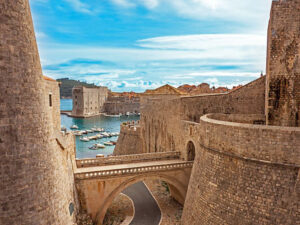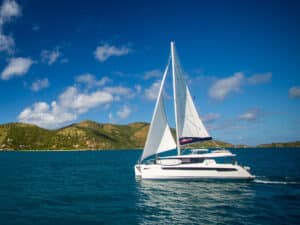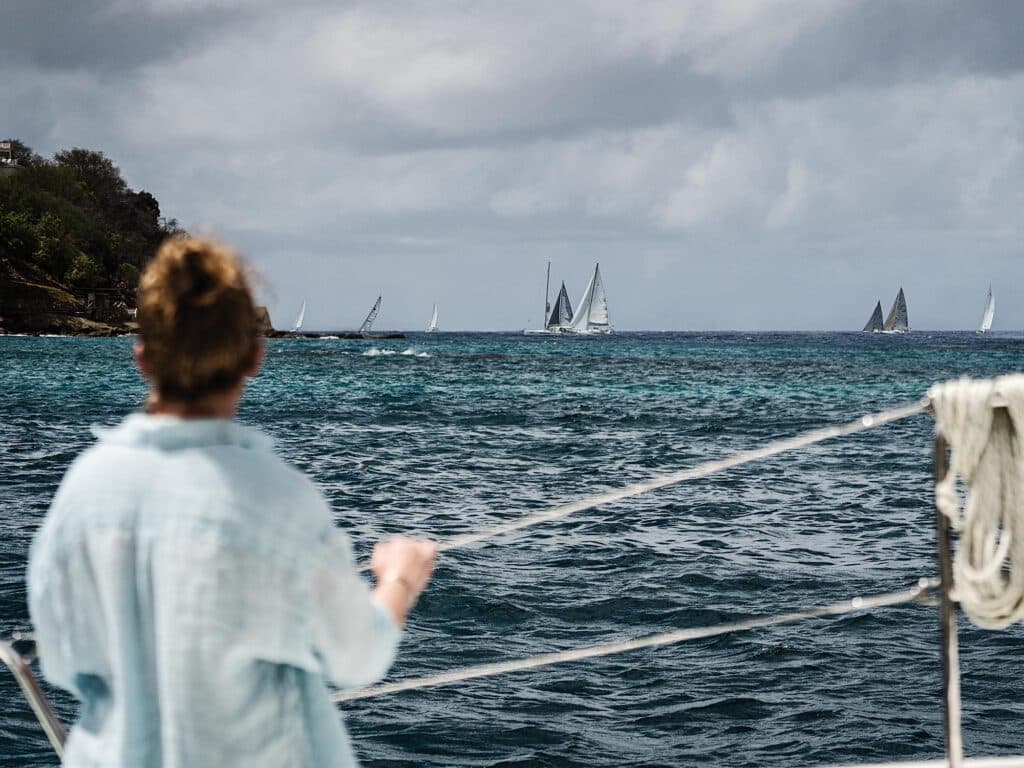
“Aww, c’mon man, don’t let us be that boat!”
I shouted at myself as I cranked the wheel and goosed the throttles, sending the Lagoon 42 Sjevernjaca into a wide, lumbering 360-degree turn. We had to get out of the path of a powered-up race boat that was bearing down on us.
Standing next to me at the raised helm station was my old sailing mate Dave Robinson. “Oh, that one’s going to be trouble too,” he said three-quarters of the way around the circle, pointing at a sailboat that tacked close to shore and was now headed our way.
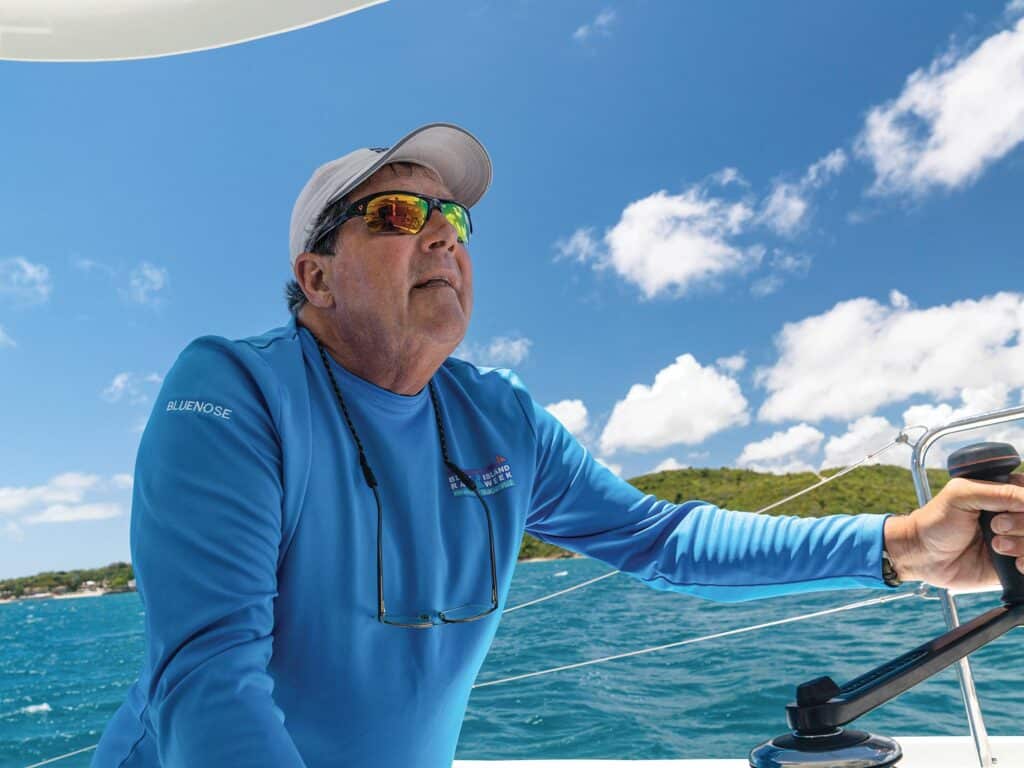
I spun the wheel hard again and searched for an open path through the oncoming traffic. The seas were lumpy off the rocky entrance of Antigua’s English Harbour.
It was Day Two of Antigua Sailing Week, which we’d come to watch, not participate in—though now, apparently, we were in the thick of it. Dream Yacht Charters was a sponsor of the event, and when they suggested that I take in a bit of the action and then sail off to see the rest of the island, well, how could I say no?
We had started two days earlier at the charter base just up the coast in Jolly Harbour. On the last Saturday in April, after provisioning at Epicurean Fine Foods & Pharmacy and then waiting for a leaking faucet to be replaced, we got a late start. Our destination was Falmouth Harbour, home to race headquarters and the first stop on a counterclockwise, weeklong circumnavigation of the island. At the chart briefing that morning, besides a rundown of must-see bays and coves (and a review of the island’s many reefs to avoid), we were told two things: Be on a mooring or anchored an hour before sunset, and keep clear of the 85-boat Sailing Week fleet.
With the first advisory top of mind, we motored out the channel in midafternoon, hung a left in open water, and made a beeline for Goats Head Channel, staying inside the reef on the island’s southwestern side. To my surprise—given that this year’s Sailing Week was the first at Antigua after a two-year pandemic hiatus—Falmouth Harbour was not all that crowded. We had no problem picking up one of the Antigua Yacht Club’s guest moorings, relatively close to its dinghy dock. It turns out the bulk of the racers preferred to crowd into adjacent English Harbour, home to Nelson’s Dockyard and a number of marine facilities.
Ashore, we learned that the opening-night party, to which we’d been invited, had been canceled because of pending weather. The bar was open, though, and the drinks were flowing. Decked out in team colors, sailors clinked bottles and glasses as regattas past were toasted. Outside, several race boats were tied along the docks, their crews offloading gear in preparation for Sunday’s opening race. And on a nearby waterfront stage, the Original Steel Orchestra entertained one and all with a lively assortment of Caribbean tunes.
For dinner, we took a security guard’s advice and walked a short way to the Life on the Corner Bar & Grill, which served up a spicy chicken curry that demanded to be washed down with cold Caribes, followed by a sweet rum punch. The street outside was busy and loud. Back on the boat, we sat forward on the tramp and enjoyed a ringside seat.
Sailing Week, according to its president, Alison Sly-Adams, marks the end of the Caribbean’s regatta season. It started in 1968 as a reason for yachts and crews to stay just a bit longer before heading north, out of hurricane danger or back to Europe. This year’s event was the 53rd regatta, offering racing action to a wide array of sailors. Boats ranged from thoroughbreds such as the Volvo 65 Ambersail 2 and the Volvo 70 Ocean Breeze to mom-and-pop cruisers to a fleet of 29 chartered bareboats. There were 15 classes in all, assigned to two starting areas just to the east and west of the entrance to Falmouth Harbour.
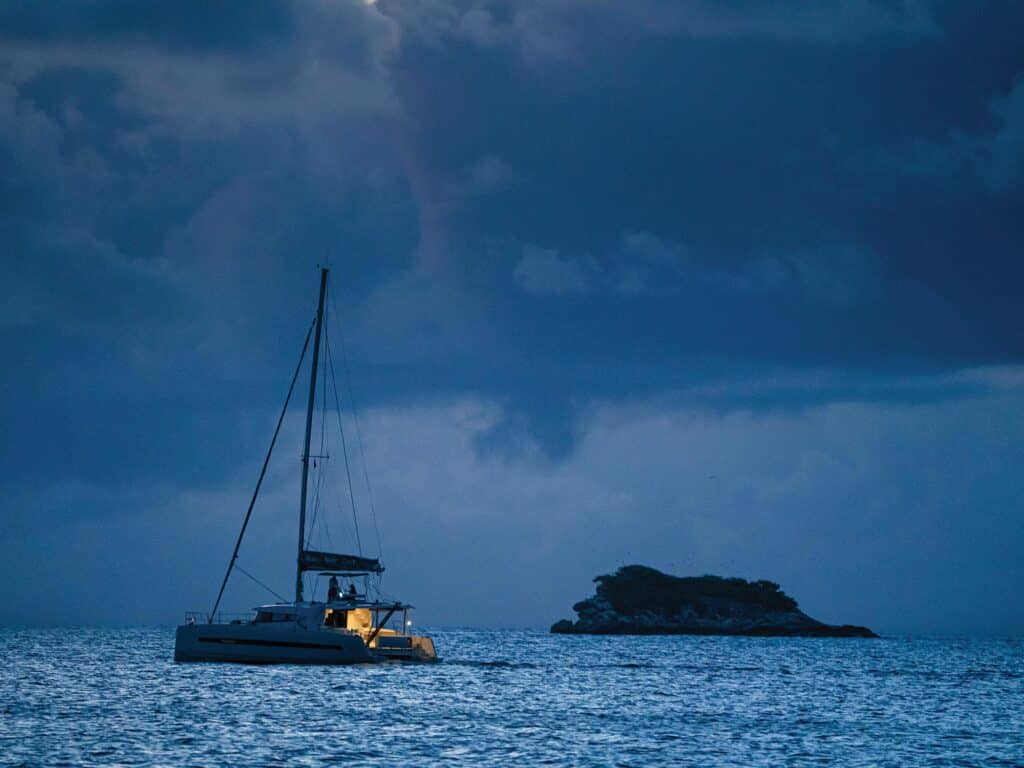
We joined the eastbound parade of boats Sunday morning to watch a few of the big-boat starts. The action began at 10, with classes taking off at five-minute intervals. By the second tack, the front-runners in each heat were lost in the Caribbean haze, so eventually we headed over to the B Fleet’s windward mark and puttered around, watching the spinnaker-optional cruising and bareboat classes at work. With a broach here, an hourglass chute there and a few collisions with the inflatable buoy, it was all entertaining enough.
The trade winds were forecast to be sporty throughout the week, and they were. After a long morning of bouncing about in the resulting swell, our crew embraced the idea of returning to the mooring to take in a little more of what Falmouth had to offer. We had an invitation to a rum party being put on by Locman, the Italian watchmaker, and then grabbed a $12 cab to Shirley Heights a couple of hours before sunset for the infamous Sunday night jump-up party.
Even on a quite-hazy evening, the view of English and Falmouth harbors from atop Shirley Heights was breathtaking. The place was packed by the time we arrived, and a long line pointed the way to the barbecue pits, where cooks prepared chicken and ribs over wood and charcoal fires. Nearby, craftsmen laid out tables filled with wares. I watched a basket weaver make youngsters happy by fashioning fanciful hats for them out of palm fronds. The bar was busy too, serving libations to a mellow crowd of sailors content to sway to the Caribbean rhythms of the Halcyon Steel Orchestra.
We watched twilight turn to dark and then headed back down to town, and from there to the boat for a hot dog feast cooked on a charcoal-fueled grill of our own. With the jump-up and Sailing Week visits crossed off the to-do list, we were ready to go exploring.
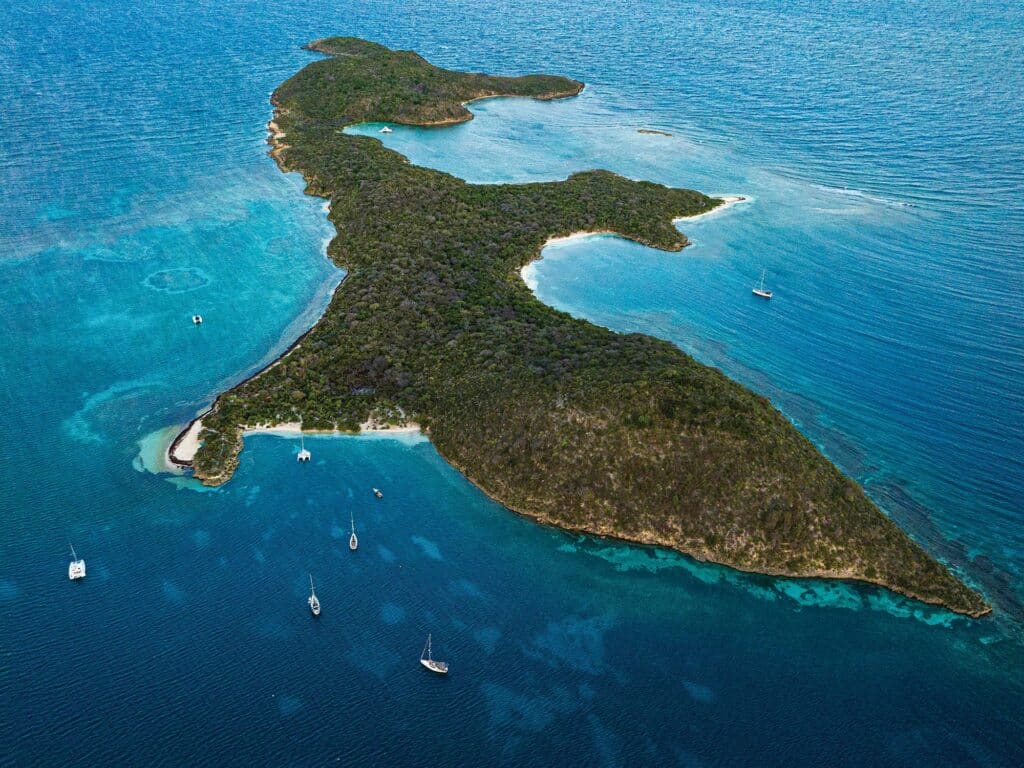
On the chart, it looked to be about 12 nautical miles to Nonsuch Bay, the first protected must-see anchorage on Antigua’s east coast that was not off-limits to Dream charterers. With just that seemingly short distance to go, we were in no hurry to get started. At the mooring, the breeze felt lighter than it had the day before, but as soon as we were outside and turned east to clear the tip of the island and proceed north, the trades were full-on, gusty and squarely in the no-sail zone of a big cruising cat. Three things became immediately apparent. First, we were in for a long, slow motorboat ride, pounding into ocean swells that made it hard to get boatspeed up to even 5 knots. Second, the A Fleet race committee had designed the day’s distance course to take several classes along the very same coast we needed to traverse. And third, we should have left a whole lot earlier in order to be out of their way.
For the better part of two hours, we played dodge ’em with incoming race boats. In all, it was a wet three-plus-hour slog up what was a textbook lee shore, with water pouring over the cabin top each time a bow buried itself in a wave or a squall rolled through. But still, it was a thrill to see the wildness of the sea, feel the power of the breeze, and take in the lush green hills and rocky outcrops that marked this part of Antigua. I’d do it again in a heartbeat, though perhaps not in the midst of a regatta.
Soon enough, we spotted a white structure on a headland that the cruising guide said looked like a lighthouse. Just past it lay the pass into Nonsuch Bay—a slice of deep water through outcroppings of rock and coral jutting out between the mainland and Green Island. As we turned and ran west, surfing down the wind-driven swells, the early-afternoon sun was high overhead, making it easy to spot the shallow spots. Closer to shore, the waves laid down, and once inside, though a gusty wind still blew, the water was calm. Relief!
Nonsuch Bay is a truly lovely place—my favorite spot of the week, I think. Inside, to the east and south, the hills are tall, with a few homes and resorts tumbling down to the water. Just past the entrance, there’s Middle Reef to skirt, with good water to either side. To the right, there were a couple of boats anchored off the northeast end of Green Island, and farther along, a handful more tucked in behind the reef.
We broke left and motored deep into the bay to what, on the chart, appeared to be a well-protected spot surrounded by mangroves in Ayres Creek. We dropped anchor in about 12 feet of water just off a resort dock, and then watched a cloud of mud billow up as we backed down and plowed the hook along the bottom.
Plan B? Head back to Green Island and anchor in sand. Besides way better holding, we found great entertainment, thanks to 40knots—a local watersports school that offers kite-, wing- and paddleboard lessons off the beach and from a sailboat anchored by the reef. We witnessed a variety of skills. There were soaring leaps and landings, as well as the occasional chase-boat rescue of a newbie blown astray. As for our crew, we grabbed masks and snorkels to sit on the beach at Green Island. Underwater, there wasn’t much to see, save for one enormous hermit crab. It was a good swim, though, on a hot afternoon.
Sunset that night was the best. The sun dipped below the hills to the south, and the water inside the reef was calm, the breeze steady. If cruising, this bay would be a place you might stay for days or weeks. Unfortunately, we were on rented time and had places to go.
Tuesday got off to another wet and bumpy start. We followed our track back out the pass, planning to motor upwind until we were clear of Green Island and could set sail for Horse Shoe Reef Channel and the entrance to Parham Sound at the north end of the island.
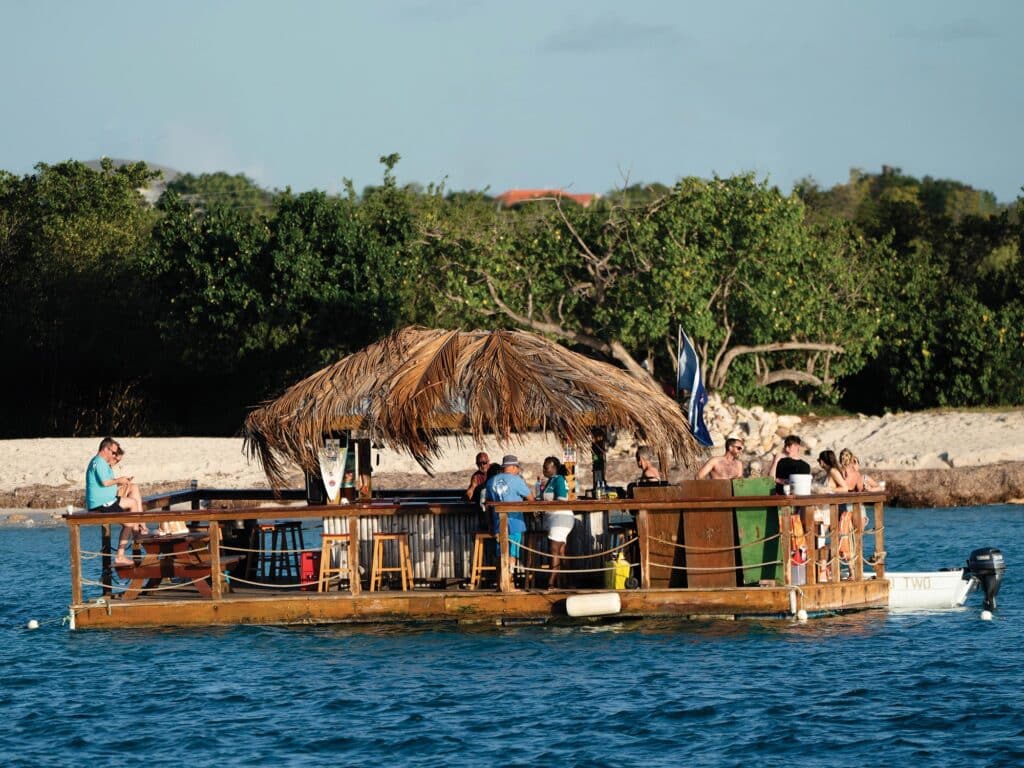
As we retraced our steps, the waves built as quickly as they’d subsided the day before. One roller caught me off guard, and rather than bearing off to take it on the forward quarter, Sjevernjaca plowed square in, burying both bows with a shudder. Stepping below, one of our crew discovered water in the hallway outside his forward cabin; inside it was more like an aquarium. A hull hatch had been left open. As if to prove a point about the power of hydrodynamics, the sea had sent remarkable amounts of water pouring in, soaking everything in its path.
At last in deeper water, the seas mellowed. We hauled up the main, cracked off, and rolled out the self-tending jib. Sailing, at last! It was a good 5-mile reach that began with breeze on the beam and ended up with us nearly on a run.
The coast along this part of the island is low-lying, making it tricky to pick out landmarks. We searched for Prickly Pear—a sandy islet just offshore that serves as a range mark through Horse Shoe Reef Channel. Once we spotted it and made our turn, even with the aid of the chart plotter, the shallows to either side of the channel were hard to spot until we were nearly on top of them, but we made it through and followed the charted route south through reefs to the sandy beach at undeveloped Maiden Island. It turned out to be a good spot to swim and kick back. With the VC Bird International Airport across the way and boat traffic passing by, there was plenty to watch. Toward sunset, two cruising sailboats pulled in, but otherwise we had the place to ourselves.
In the morning, we set sail and picked our way back along the shore, passing inside Prickly Pear, bound for Boon Channel. The route kept us well off the reefs to the north. In daylight, with a chart plotter, this was an easy passage, but looking at the Imray Iolaire chart on board, I once again had a great appreciation for Don Street plying and charting these waters with a compass and lead line as he mapped and wrote his cruising guides aboard the engineless yawl Iolaire.
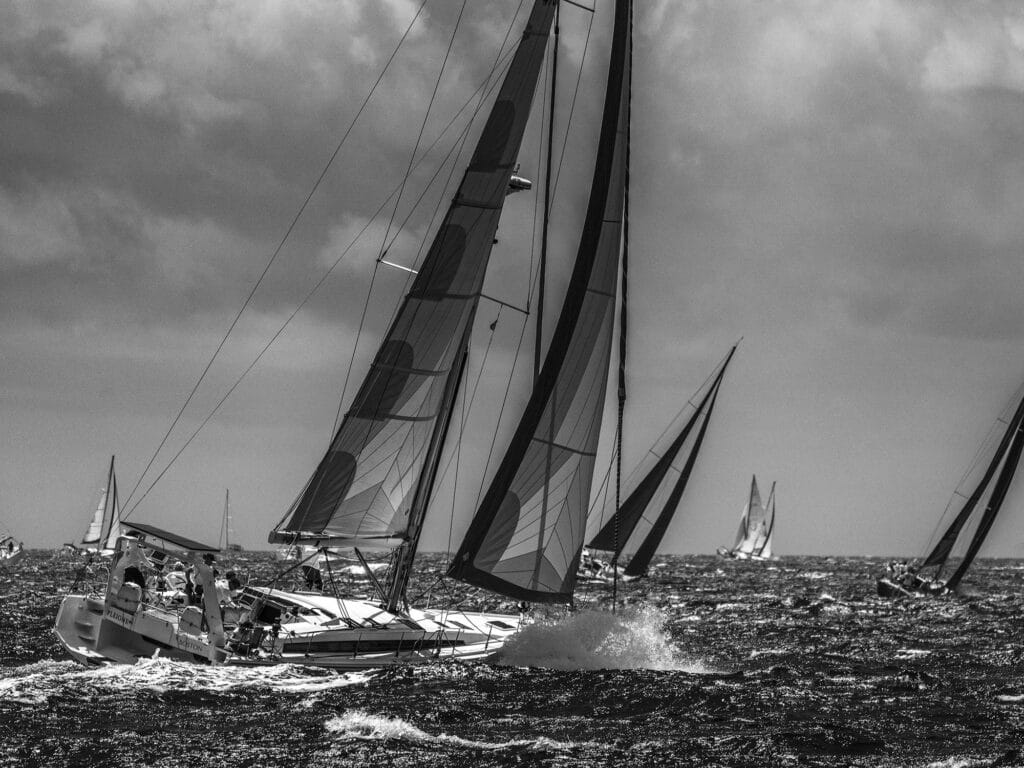
Our journey that day—and for the rest of the trip, for that matter—delivered a nice, but brief, sail. The distance from Maiden to Dickenson Bay is just 7.5 miles, and we flew along with the still-gusty trade winds behind us. Dickenson is home to Sandals and a couple of other all-inclusive resorts that dominate the long, crescent beach, but we found an open stretch at the south end and anchored there late morning in about 9 feet of water, near a thatched-roof raft known as the Kon Tiki Bar.
After lunch and a swim, three of us were eager to go ashore and stretch our legs. With no good place to land or leave a dinghy, one of our crew dropped us at the beach, where we followed a rutted dirt road to a paved one. Resorts lined one side of the street; on the other, we strolled past a large pond and an abandoned miniature golf course, complete with a faded cruising catamaran that doubled as a hazard. A local pointed us in the direction of a small convenience store, saving us a long walk or cab ride to a market to replenish our dwindling stock of beer and chips.
Later that afternoon, we visited the tiki bar—our first watering hole since Falmouth that wasn’t all-inclusive and that was open to non-guests. It was a lively place, and “Johnny from Denmark” ruled the bar. He was quick to serve us a cold Caribe when we stepped aboard from the inflatable.
Johnny had a tale to tell. He’d come to the island for a two-week visit 22 years earlier and, well, fell in love with the place. He managed a restaurant on the beach for several years but lost it when the owner died and it changed hands. Four years ago, he made good on a dream to build and open the Kon Tiki Bar along with his better half. The pandemic was a setback, and, added to that, he and his partner split up, he said. Now he gets the raft for a week, then takes his liquor home, and she brings her own booze for the next. “That’s just the way it goes,” he said with a shrug. “I’m working one week, then I have a week’s vacation.”
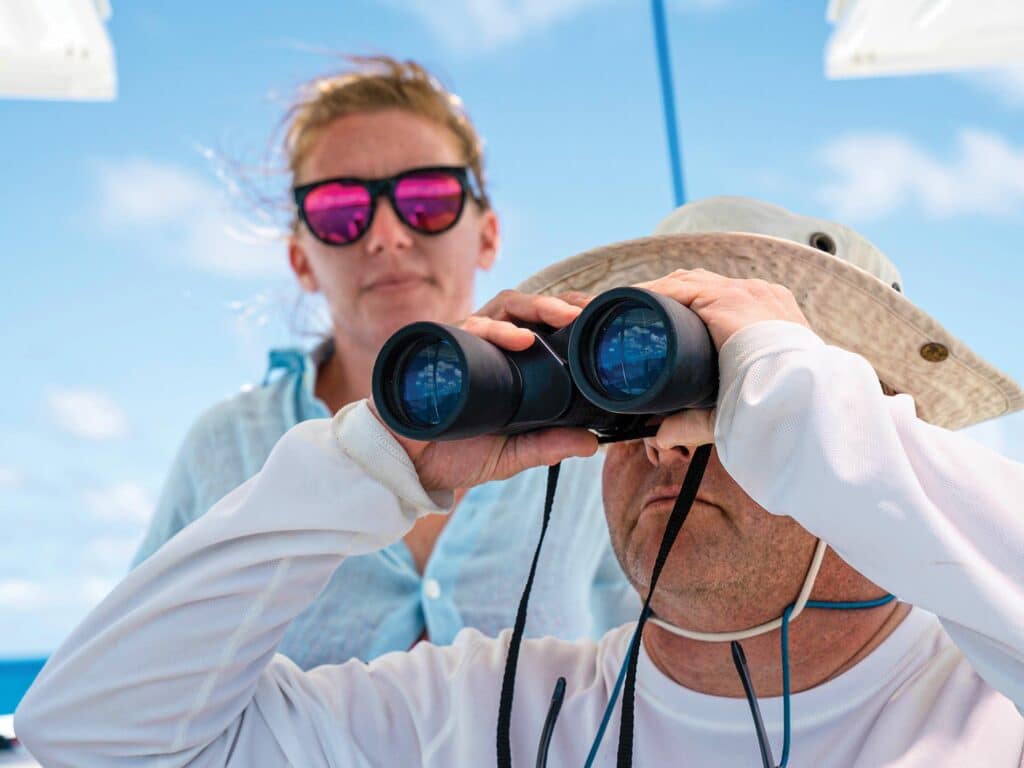
An assistant sat off to the side of the bar and manned a runabout to ferry visitors back and forth to shore if they didn’t want to make the short swim. As the day went on, the number of visitors grew and the music got louder. By the time we left, it was packed with a raucous crowd awaiting sunset.
Thursday was our last full day aboard Sjevernjaca, and as the crow flies, we didn’t have far to go to skirt the entrance to St. John’s Harbour and arrive at our next destination, Deep Bay. The breeze was still honking from the northeast and we were in no hurry, so we hoisted sail and struck out on a long reach out to sea and back, getting in a couple of hours of good sailing before dropping the hook.
Deep Bay was yet another lovely destination. As we motored in, we had no trouble spotting and avoiding the wreck of the Andes, a barque that had caught fire and sunk while carrying pitch to Chile in the early 1900s. Inside, we anchored in about 9 feet of water.
The Royalton Antigua resort takes up the southern end of the beach, and a few small shops dot the shore, but most of the strand is backed by lush green shrubs that hide a salt pond behind. Ashore, we scrambled up the steep path to Fort Barrington, built by the British in 1779 on the headland overlooking the approach to St. John’s. The view was spectacular. We could just spy Montserrat through the afternoon haze, and we got a panoramic view of Antigua’s mountainous interior.
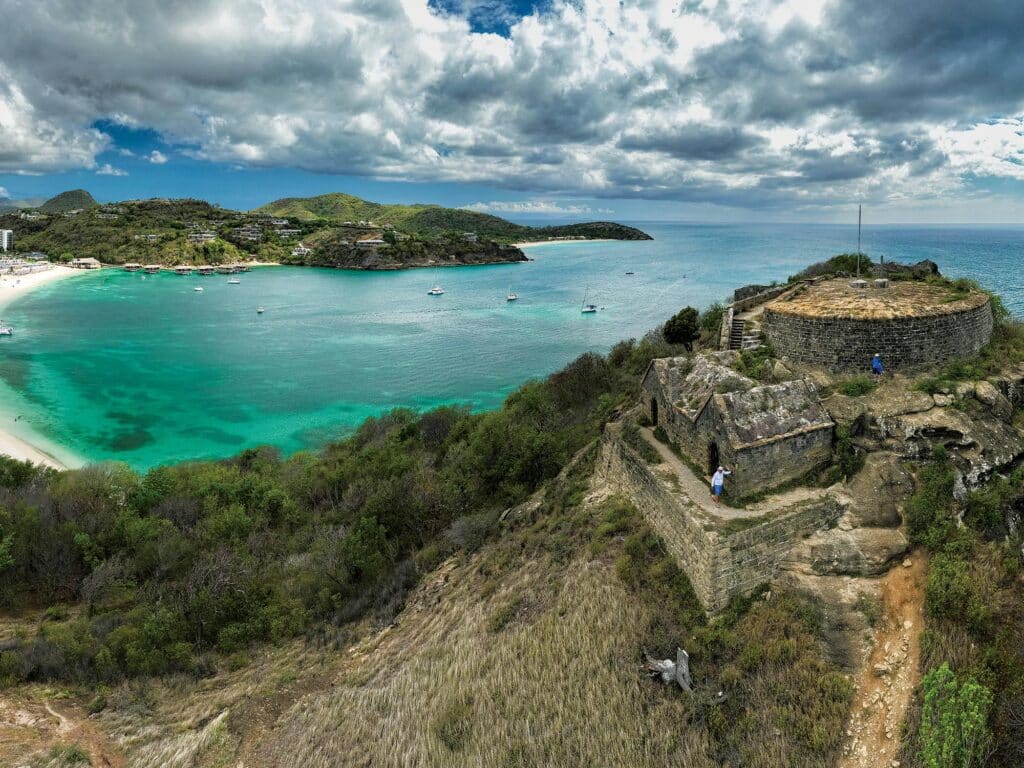
Friday, we managed to create another extended sail for ourselves by reaching out past Sandy Island and its off-lying reef, and circling back to visit pretty Hermitage Bay and Five Islands Harbour, where the Shekerley Mountains tower over the anchorages. We stopped for lunch and a swim, and lingered as long as we could before motoring out and around the point, back to Jolly Harbour and the charter base. It had been a fine week with plenty of breeze for sailing, a happy crew, and sights to see.
Saturday morning, as we cleaned the boat and packed, I spotted the crew from Talitha on the dock. I’d met them at the start of the week, when they were getting their rented Beneteau Oceanis 41.1 prepped for action. Skipper Jeff Dickinson along with the rest of the crew of eight all hailed from Aspen, Colorado, and are members of the Aspen Yacht Club. It was his third Caribbean regatta, he’d said. And of course, they expected to win their bareboat cruising class.
“I love Antigua,” he told me. The pace of the regatta is just right: two to three hours of racing, then a party, plus a lay day for scuba diving.
So how did they fare?
Well, they had fun. Dickinson was back at a rented condo where half of the crew had stayed at night. But his mates who returned the boat reported that Talitha was first over the line in three races—a victory of sorts—though they ended fifth overall on corrected time. One thing they were certain about: They’re coming back to race again. “Absolutely.”
Mark Pillsbury is a CW editor-at-large.
Charter Racing
Antigua Sailing Week is one of several Caribbean regattas that include a charter-boat division. For this particular week of racing, Aspen, Colorado, skipper Jeff Dickinson said that charterers can’t request a particular boat and can’t campaign the same boat two years in a row. § Erin Minner, Dream Yacht Charter’s sales manager for the Americas, says that racers have a few other requirements to consider. The minimum charter time is 10 days. There is a race-pack charge that includes a more detailed boat briefing and a check to ensure that sails are in good shape. The base registers the boat with race officials. There is a regatta surcharge of approximately $2,000, depending on the boat and event, and the security deposit is doubled. Dream Yacht Charter lets its boats participate in Antigua Sailing Week, the Caribbean 600 and the BVI Spring Regatta. § If you’re planning to escape winter and go racing, check with the regatta and local charter bases for yacht availability.



